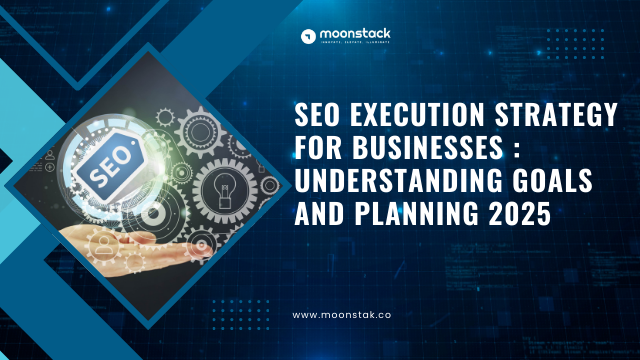How to install React Compiler and ESLint plugin


SEO isn’t just about tactics – it’s about setting the right goals, crafting a strategic vision, and executing a clear plan, which you will learn in this post.
What Is an SEO Strategy?
An SEO strategy is a plan for creating, optimizing, and promoting content to increase its traffic in search engine results, resulting in more organic visitors to a website. Keyword research, on-page optimization, technical SEO, and link building are some of the tactics used.
In other words, Search Engine Optimization strategy is the procedure you follow to increase organic traffic.
Create a List of Keywords:
Keyword research is typically the first stage in any legitimate SEO campaign.
And what’s the best technique to uncover keywords that your target buyers look for?
Google Suggest
When you type a keyword into Google’s search area, it will provide a list of suggestions:

These are typically excellent SEO keywords because they come directly from Google.
(This suggests you know that people are looking for them.)
Furthermore, longer keywords (known as “long tail keywords”) are typically less competitive than “short tail” terms.
So, despite their low search volume, long tail keywords are considerably easier to rank for.
I recommend entering several different keywords into Google until you have a list of roughly ten keywords.
If you want to check the search volume and competition levels for those phrase, you can use a keywords tool like Semrush, Ubersuggest. Or Google keyword Planner tool.
3 Key Benefits of SEO for Businesses

Businesses SEO requires time, money, and resources to get started, but the long-term benefits are well worth it.
These major benefits are critical to your company’s ability to regularly generate leads and develop revenue.
Enhanced Brand Visibility:
SEO makes it easy for consumers to locate your business, whether they’re new to it or already know about it—especially if you optimize to be on the top page.
According to HubSpot, 75% of users never search beyond the first page of results. Furthermore, standing at the top provides you a significant edge over paid ads.
According to FirstPageSage research, the top organic result receives 39.8% of clicks, while the top paid ad receives only 2.1%.
For customers who are already familiar with your brand, appearing at the top of search results—especially when they are ready to make a purchase—increases the likelihood that they will visit your site and convert.
Consistently showing in search results also helps develop brand awareness among those who are unfamiliar with it. Over time, this familiarity develops into credibility and trust, making customers more inclined to choose your company when they are ready to act.
Better customer engagement:
SEO increases customer engagement by making your website easy to navigate and full of useful and interesting content.
When visitors can easily locate what they’re looking for, they’re more likely to stay and explore other pages, subscribe to your email, or make a purchase.
Inside Buzz, for example, increased homepage engagement by 17.8% simply by streamlining the design and eliminating clutter. Additionally, businesses with active blogs earn 67% more leads each month than those without.
Positive engagement signals like these tell Google that your material is valuable, which helps to boost your search ranking.
Furthermore, information that is truly useful is more likely to be shared on social media, attracting new visitors who would not have visited your website otherwise. As more people participate and share, your reach expands, attracting even more prospective consumers.
Improved Website Performance:
Businesses websites frequently experience slow loading times, which can be attributed to issues such as sophisticated site architecture, big media assets, and inefficient coding.
Compressing media assets, enhancing browser caching, lowering CSS and JavaScript, and utilizing content delivery networks (CDNs) can significantly improve the overall performance of Businesses websites.
This enhancement keeps visitors on your website longer and boosts their likelihood of engaging with your business. It also improves your search engine rating, bringing more traffic from search to your website.
How to Successfully Execute Your Business SEO Strategy
As previously said, the SEO methods for tiny websites also apply to company blogs, but the implementation is different.
Success frequently depends on how well you communicate, organize, and plan with others in the business to make your objectives a reality.
Here’s a strategy for making that happen:
1. Understand Your Business Goals and Audience:
Before diving into corporate SEO strategy and execution, take a step back to better understand the company’s objectives and how SEO fits into them.
For example, if the company wants to grow revenue from a specific product line, your SEO plan could include optimizing product pages, generating supporting content such as buying guides and how-to articles, and targeting transactional keywords that are relevant to consumer intent.
It’s equally crucial to know your audience inside and out.
Who are they, and what are they attempting to solve? Examine their search history, the type of material they enjoy (whitepapers, case studies, blog pieces, etc.), and their goals (learning something new or making a purchasing choice).
Understanding these two factors provides a solid foundation for your company SEO strategy, aids in work prioritization, and produces real outcomes.

2. Prioritize SEO projects:
With Businesses SEO, the number of tasks available can be intimidating.
Prioritizing your initiatives is critical because it allows you to focus on those that will have the most influence on your business objectives. Without this concentration, you risk becoming bogged down in chores that do not make a big difference or contribute to meaningful progress.
To find high-impact projects, you can utilize simple prioritization methods such as the Impact-Effort matrix or the RICE (Reach, Impact, Cost, Effort) framework.
For example, you could end up with an Impact-Effort matrix that looks like this:
3. Secure Stakeholder Buy-In:
Getting stakeholders on board is a critical step in successfully implementing an Businesses SEO strategy. To gain their support, demonstrate how SEO is directly tied to the company’s goals.
Make the benefits plain and tangible by using genuine statistics, such as revenue estimates and long-term cost reductions from paid advertising.
Meanwhile, the products or engineering team (or any other team with which you must cooperate) may be more concerned with how SEO efforts might make their jobs easier and avoid future headaches.
For example, you may explain to the engineering team how the tasks you’ve assigned them would improve site performance, decreasing server pressure and concerns about poor load times.
4. Establish communication channels:
When performing Businesses SEO, you will collaborate with numerous teams, including product, engineering, and content.
So, to avoid confusion, make it obvious who is accountable for things like technological difficulties and content production. Tools like Asana, Trello, and Slack make it easy to organize SEO initiatives, assign them to team members, discuss updates, and track progress to keep things on track.
Regular check-ins are also useful for analyzing what has been accomplished, resolving any issues, and altering priorities as needed.
5. Evaluate expertise and resources:
Businesses SEO requires a lot of management, from technical audits to link building and content creation. Check your team to see if they have the expertise and bandwidth to manage everything.
If your workforce is stretched thin or lacks the necessary skills, consider hiring outside labor to cover the gaps. You may employ an agency for specific duties such as technical audits or large-scale link building, or you could use freelancers to assist scale high-quality content production.
6. Invest in the right tools:
Not all SEO technologies are designed to manage the high data volume and complex requirements of Businesses blogs.
So, when selecting tools for tasks such as keyword research and site audits, look for tools designed with corporations in mind, preferably with a track record of dealing with major companies.
While popular platforms like SEMrush and Ahrefs can handle a variety of SEO duties, they may fall short in other areas, such as advanced site auditing. Deepcrawl, OnCrawl, and ContentKing are excellent tools for conducting in-depth site audits and real-time monitoring.
Regardless matter which tools you use, they should be able to interact with your tech stack, accommodate numerous team members, and give advanced reporting.

7. Monitor and report performance:
Set up your analytics tools to monitor organic search traffic, keyword ranks, conversions, revenue, and other critical performance indicators.
Share these information with stakeholders on a regular basis, using simple, clear visualizations. Highlight your successes, explain what is driving the results, and identify opportunities for improvement.
This keeps everyone updated on your success and encourages continued support for your SEO endeavors.
Top Tools for Businesses SEO Blogging
Many tools will assist you in carrying out various aspects of your Businesses SEO plan, but here’s a selection of the best options that cover multiple use cases such as keyword research, site audits, backlink tracking, and reporting:

Connect with Moonstack
Ready to take the first step towards unlocking opportunities, realizing goals, and embracing innovation? We're here and eager to connect.


